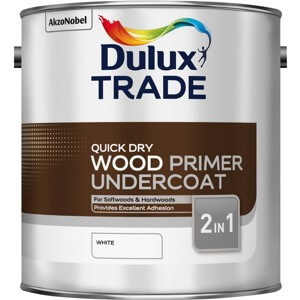Quick Drying Wood Primer and Undercoat. Water based. COSHH Assessment Form

A pre-filled COSHH Assessment Form for Quick Drying Primer and Undercoat, with some example text reading:
Spillage and environmental:
Mobility: Store in an upright position and ensure the container is tightly closed.
Accidental release: Do not discharge into drains or rivers. Contain the spillage using bunding, then absorb it into dry earth or sand. Transfer to a closable, labelled salvage container for disposal by an appropriate method.
Avoid breathing vapours.
Clean residue with a detergent; avoid use of solvents.'
Wood primer and undercoat play a crucial role in preparing wood surfaces for painting, serving as a foundational layer that significantly enhances the overall quality, durability, and longevity of the paint finish. While the terms "primer" and "undercoat" are often used interchangeably, they refer to distinct applications in the painting process.
A primer is typically the initial layer applied to bare or previously painted wood surfaces. Its primary function is to prepare the wood by sealing its pores, which creates a uniform and stable surface where the paint can adhere effectively. This layer is crucial in enhancing the bond between the wood and the paint, which in turn helps to prevent common issues such as peeling, cracking, or chipping over time. Additionally, primers are formulated to block stains, tannins, and other potential discolourations from affecting the topcoat, ensuring that the final paint colour remains true and vibrant. Furthermore, primers act as a protective barrier, shielding the wood from damaging UV rays and moisture, which can significantly prolong the life of the painted surface.
Various types of primers are available, depending on the specific project requirements. For instance, oil-based primers are particularly effective for bare or unfinished wood, as they penetrate deeply and create a strong bond. On the other hand, shellac-based primers are recommended for surfaces that have been stained, as they are excellent at covering dark or uneven colours.
Following the application of primer, an undercoat is then applied to further refine the surface. The purpose of the undercoat is to create a smooth and even base for the final layer of paint. This layer is designed to cover minor surface imperfections, such as small scratches or asymmetries, thereby ensuring that the topcoat adheres seamlessly and looks flawless upon completion.
With an all-in-one undercoat and primer, only one coat is required.
This document is:
- Recognised by local authorities
- Recognised by principal contractors
- Suitable for CDM sites
- Approved by H&S managers
If you want others to have confidence in your company, download and buy the proper documents today.
As with all our documents, our risk assessments come in Word™ format and are available for instant download and use, and you only need to buy them once.
Once you buy and download this document, it’s yours for life to use repeatedly.
Why not browse the HSEDocs catalogue of method statements, risk assessments, COSHH assessments, or industry-specific packages?
And for safety training relevant to your job, visit our online training courses.
GET THIS DOCUMENT
£8.99+VAT
- Available in Word™
- Fully customisable
- Add your Company Logo
- UK & EU Compliant

 CART
CART 